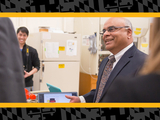Dr. Rao speaks to the future of sensors & Bioprocessing 4.0
Excerpt from GEN News
Bioprocessing 4.0 Depends on Advances in Optical Sensors
By Mike May, PhD | January 18, 2022
Excerpt from Genetic Engineering & Biotechnology News (GEN)
The move to Bioprocessing 4.0 depends heavily on advancing sensor technology. Only then can one accurately monitor and control biochemical reactions occurring in living cells. At the University of Maryland, Baltimore County (UMBC), Govind Rao, PhD, professor of chemical, biochemical, and environmental engineering, and director of the center for advanced sensor technology (CAST), and his colleagues develop new sensors that help bioprocessors move from batch to continuous processing. One of the key elements to monitor is oxygen.
“Oxygen is the critical metabolic requirement for aerobic cells in culture and is the hardest to supply to cells due to its low solubility,” Rao explained. “Consequently, monitoring its presence is critical.”
Optical sensors offer promise in this area for oxygen and more. When asked about the most important recent advance in optical sensors that can be used in bioprocessing, Rao said that it’s “the ability to monitor multiple parameters in a non-invasive manner.”
Although research on optical sensors plays a fundamental role in their development, bioprocessors look for technology that can go into manufacturing facilities. That’s just what Rao develops. “All our sensors are designed for commercial application and in fact several are on the market,” he said
Image: Govind Rao. Photo courtesy Marlayna Demond ’11 for UMBC.
Posted: January 21, 2022, 9:40 AM
